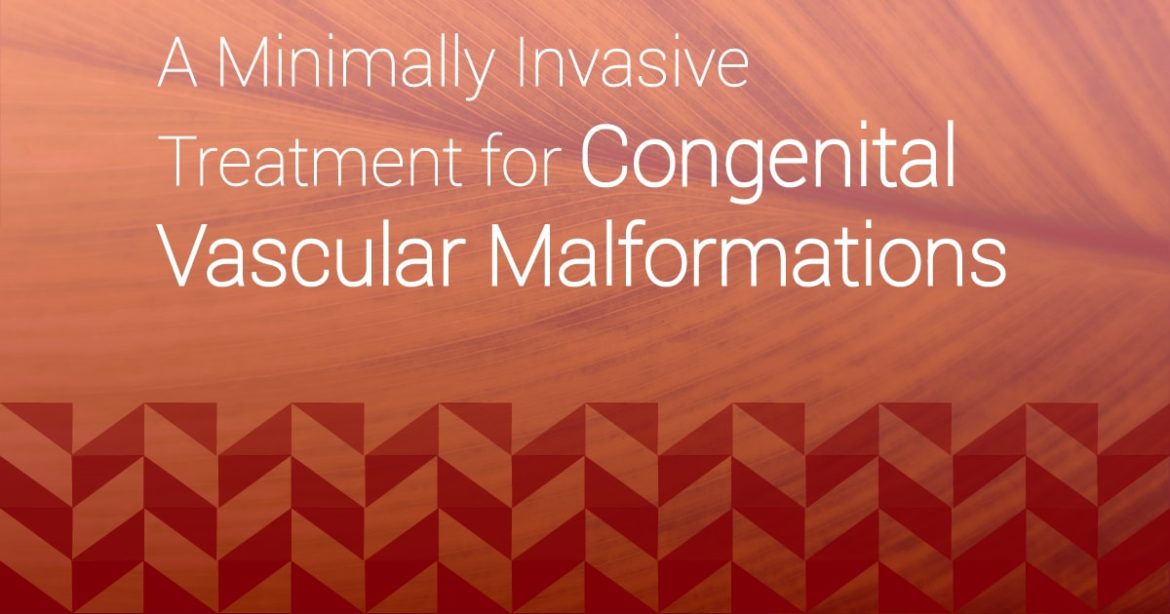The vascular system (also called the circulatory system) is a network of vessels that carry blood throughout the body, delivering essential nutrients and oxygen and taking away waste material. Sometimes these vessels are not formed normally (malformed), are connected abnormally, or are not formed at all. This condition is known as a Congenital Vascular Malformation and affects the body in many different ways. At UVA Interventional Radiology, we provide treatment for a variety of vascular malformations.
Article Reviewed by Dr. Alan Matsumoto
What are Congenital Vascular Malformations?
Congenital vascular malformations (CVM) is an umbrella term for abnormal clusters of blood vessels formed during fetal development—whether made up of arteries, veins, capillaries, lymph vessels, or a combination of these vessels. CVM is rare, present in about 1% of all births, and varies from harmless birthmarks to painful growths that can cause pain, swelling, and bleeding.
While many of these malformations are apparent at birth and grow as the child grows, some CVMs do not become detectable until later. The abnormal blood vessel connections may be more apparent during developmental changes (such as puberty or pregnancy) when blood flow increases.
Types of Vascular Malformations & Symptoms
As mentioned above, vascular malformations can form from abnormalities in a variety of blood vessels. They vary greatly in appearance, and each come with their own set of symptoms and complications. Vascular malformations are named according to the type of blood vessel that is primarily affected. These include venous malformations, lymphatic malformations, capillary malformations, or arteriovenous malformations.
Venous malformations are the most common, and appear as unsightly dilated veins or clusters of veins on the surface of the skin. Lymphatic malformations can cause swollen or enlarged lymph vessels that look like tiny water balloons underneath the skin. Capillary vascular malformations affect the very small blood vessels underneath the skin, and are nick-named “port wine stains” because they appear as patches of pink or purple skin. Lastly, Arteriovenous malformations (AVMS) occur when there are abnormal and direct connections between the arteries and veins. While AVMs are the rarest form of CVMs, they pose the most serious health threat. AVMs can lead to high blood flow from the artery, significant pain, bleeding, and even strain on the heart.
Diagnosing Vascular Malformations
While some CVMs may be apparent at birth, many go unnoticed until later in life or become apparent due to some localized trauma. Since CVMs are distinguishable by their visual appearance, your doctor will first perform a physical exam. This is usually followed by more detailed imaging tests to diagnose and better define the type and extent of the CVM. These imaging tests may include an MRI, CT, ultrasound, or an angiogram.
An angiogram is a special type of X-ray used to look at blood vessels that have been injected with contrast dye using a small tube (catheter).These pictures give the doctor a clearer understanding of how the blood vessels are flowing and help to define the type of CVM present. They are also used during treatment sessions, especially for AVMs and capillary vascular malformations.
Symptoms and Treatment
Because CVMs are so complex and vary widely—not only in the types of blood vessels they involve, but also in the location and severity of symptoms—treatment options vary widely as well. Symptoms of CVMs range from cosmetic concerns to daily pain, formation of blood clots, bleeding, skin breakdown or ulcers, strain on the heart, nerve injury, or loss of functionality in the areas of the body they affect.
After your doctor diagnoses a CVM, they will work to understand the type, extent and significance of the CVM. Once your doctor has a thorough understanding of the unique CVM, they will work with you to find the best treatment option specific to you.
In the past, surgical removal was the only treatment option for these vascular anomalies. Now interventional radiologists offer less risky, minimally invasive treatment options for this condition.
Embolization as Treatment for Vascular Malformations
The interventional radiologists at UVA offer a variety of specifically tailored, minimally invasive treatment options for CVMs. Embolization is a technique used to slow or permanently cut-off blood supply to and from a CVM.
In this procedure, interventional radiologists use fluoroscopy (a type of continuous X-ray picture) to see inside a patient and guide the treatment of the abnormal vessels. A small catheter or needle is used to administer blocking agents, such as medical grade glue, small beads, liquid agents that cause the abnormal vessels to clot off, or metal coils or plugs that block the flow of blood.

The embolization procedure is done to reduce or eliminate the size and symptoms related to a CVM, as well as the risks of bleeding, skin ulceration, or heart strain. Depending on the size and location of the malformation, it is typically necessary to perform more than one procedure in order to reduce the symptoms and the size of the CVM.
If you or your child has a vascular malformation, talk to your doctor and ask about a referral to the Interventional Radiology team at UVA. You can also directly call the Interventional Radiology Clinic at UVA at 434-924-9401 and request a consultation with one of the Interventional Radiologists.



